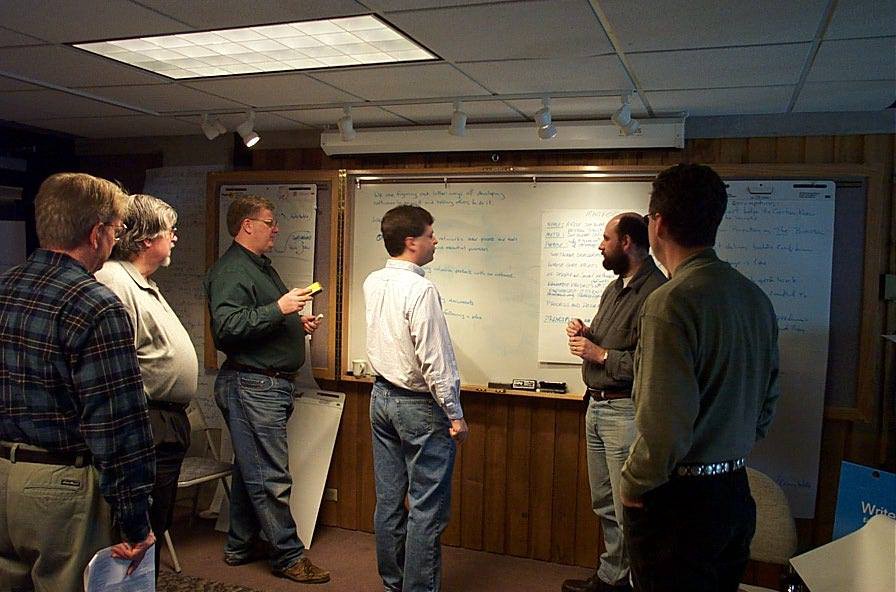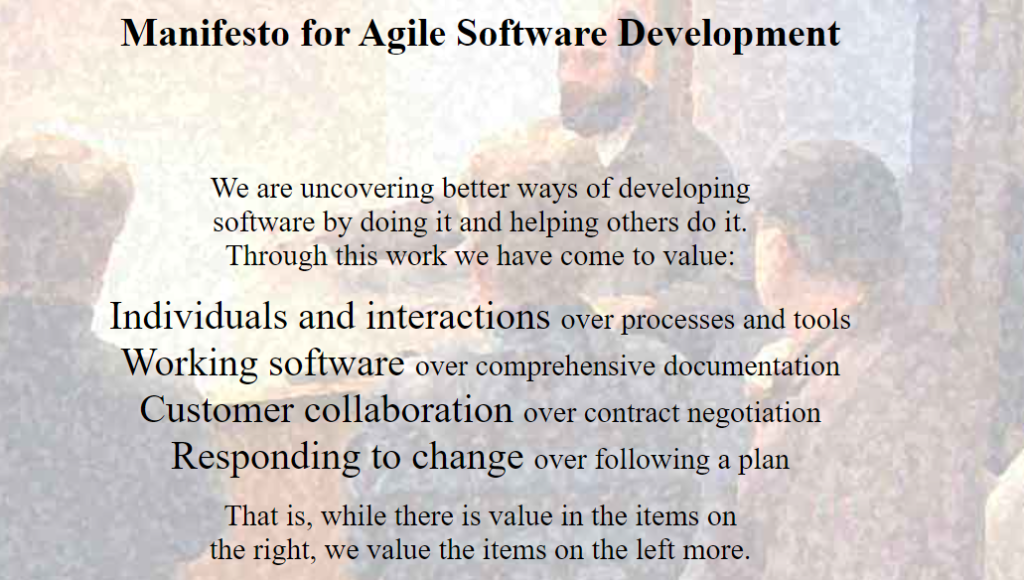[Sprint Inter(e)view] Alistair Cockburn – Part 2

DURING AGILE MANIFESTO
Legend says that you met in a mountain chalet and signed the Agile Manifesto around a Savoyard fondue and white wine! Myth or reality? Can you tell us about Manifesto signature?
LOL. Not quite. Bob Martin wanted to hold the workshop in Chicago in February, which everyone who has been to Chicago in February knows is ugly cold. Jim Highsmith and I were living in Salt Lake City, home of the 2002 winter olympics and home of great snow. I was already planning a workshop like WOOD for February, 2001, so I just pivoted my plans and offered to do the organizing if we held it at Snowbird.
So at least the ski resort part is true. The Aspen room at The Lodge at Snowbird. A nice little meeting room with a good view of the slopes. Just as with WOOD, we arranged for meetings in the morning and evening, with afternoon for conversations on the slopes or in the bar, however people preferred.
All the writing was done in the Aspen room on the whiteboard there. We sat in a half circle around the whiteboard – with no wine in sight – and word-smithed the first part of the manifesto until we had unanimous agreement on every word. The principles section wasn’t quite so lucky, but the values section was unanimous to the word.

We speak less of the twelve principles of Agile Manifesto. What is the link/the story between the 4 values and the 12 principles?
Values are high level, but already 2nd level.
We spent an hour searching for a word, to begin with. At the end of the hour, we had two words in a tie: Agile, and Adaptive. After some more discussion and a final vote, Agile came out ahead of Adaptive. Personally, I think you need both, but in all cases, Agile became the word.
Then we said, “Nice word… But what does it stand for?” And after some hours, wrote the values section appeared, to anchor what we intended with that word.
Then we said, “Nice values… But what do those mean in practice?” And so we started on the principles. But at this point we started having more significant differences, either in expression or in advice. Also, people started to leave for their flights. So we never got complete agreement on the principles.
Personally, I suspect that every co-author finds one of the principles a bit jarring to them. For me it is the “emergent” one: “The best architectures, requirements, and designs emerge from self-organizing teams.” Well, also the phrasing ” Welcome changing requirements, even late in development.” I would rather they didn’t change, quite frankly. It would be really nice if they didn’t. However, since I know they will, “Agile processes harness change for the customer’s competitive advantage.” This part is true. So it’s just the phrasing of the first part that makes my skin creep.
I’ll bet that each one of us has trouble of some sort with at least one of the principles. Not enough to veto it, but with some wish to tune it.

In your opinion, why there are no women signatories of the manifesto?
There were very few women working on methodologies at the time, so there was nearly no one to invite besides Adele Goldberg and Rebecca Wirfs-Brock.
Adele had pretty much backed out of that work by that time but could have been there. Rebecca just should have been there. It was totally her space. She had particpated in patterns work, she had been at the WOOD workshops, she was a great advisor to my first book, I had invited her to the WOOD 1998 workshop that I organized. Honestly, I gnash my teeth every time I think that I didn’t notice she wasn’t on the list of invitees.
But those are the only two women I can think of who were working in the methodology design space in the late 1990s, so even now I can’t suggest someone else who would have been there.
I should say one thing. At the end of the meeting, we asked ourselves if we should keep the manifesto updated over time. And someone pointed out that the writing was a very specific result of exactly those 17 people in the room at the time. That if anything changed, the place, the year, the participants, the result would have been totally different.
So, if Rebecca or Adele or another woman had been there, we would not just have slightly different wording, we would have had an unknowably different workshop.

Do you think this manifesto was going to have such a big impact in the IT world and other areas?
We obviously knew it would have impact. We had many high-publishing people in the room, with large reach, and we were really happy with the writing. I knew I had to memorize at least the Values section and had that memorized by the time I drove to the bottom of the canyon.
But what actually happened was so much faster and so much bigger than what we imagined. Thousands of people were already doing or were hungry for these ideas. Over the next decade, agile groups just outperformed all the other groups that even the IEEE, SEI and PMI had to join in. Now some variety of agile is mandated by government agencies, it is being used outside of software. I don’t think any of us foresaw this level of impact.
AFTER AGILE MANIFESTO
Do you think that the manifesto is still pertinent in current society?
It’s important to recognize that we were fighting a particular battle at the time. The right-hand side of the values tells you who we were fighting. The Software Engineering Institute was driving process-focus. Rational with the Rational Unified Process was driving tools. The Project Management Institute was driving contracts and plans.
What we were basically saying was, “Please just let us talk to the customers and deliver code for them to look at! And then fix it up to suit them better”
We couldn’t even do that.
So when people complain that we focused “only” on working software and not enough about customer value, I would like them to notice that we won that particular war that was in play in 2001. By now the battle has shifted to a different place.
The part that stays valuable even today is the selection of the four values.
There are dozens of things that are really important to focus on during any project, but imagine that you only get four or five to write in stone and live from for the rest of your life – Which four would you pick?
We chose:
- Individuals and interactions
- Customer collaboration
- Working software (as opposed to just documents)
- Responding to change
Those four values are still a pretty good set of values to live from.
I recommend every team go through this exercise and see what they come up with. They will be different from our four, but probably also really potent.
Have you participated in the creation of Scrum?
No, I had nothing to do with it. I read of it in 1994, when they wrote their first article.
Do you think that frameworks should evolve? If yes, why?
I am on record as saying that every project needs its own, specific methodology, tailored to them. That means that in an ideal world, we should have a whole catalog of methodologies and frameworks, each being listed with the situation in which it was found useful.
If we had that catalog, project teams could flip through the catalog to find other projects that were operating in similar circumstances, pick one or two to copy and evolve from, and then tune their working style from there. And then, if they like what they had done, write it up and add it to the catalog.
So, the frameworks shouldn’t evolve, they should used and discarded, and new ones formed, all the time. This is, it might not come as a surprise, the basis for the Crystal family of methodologies. 🙂
